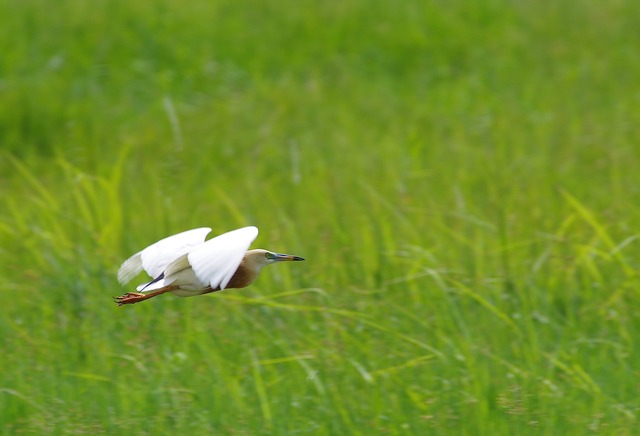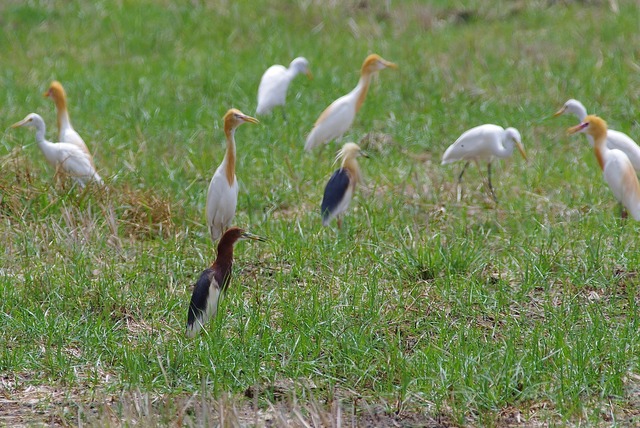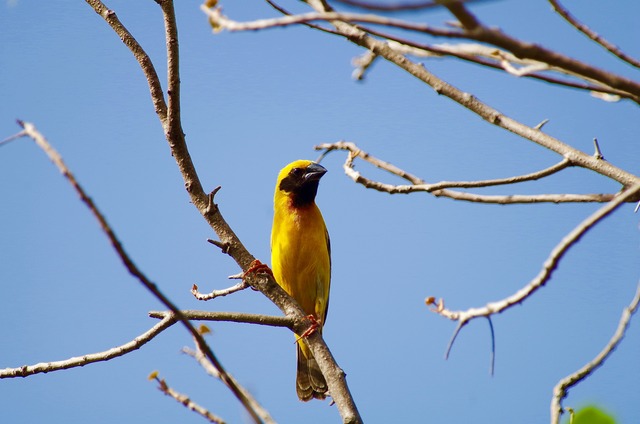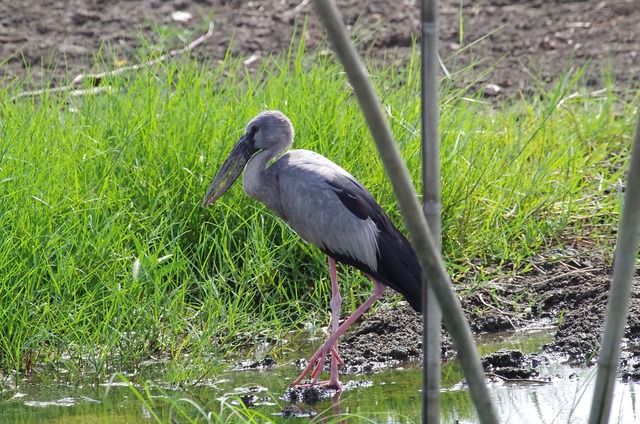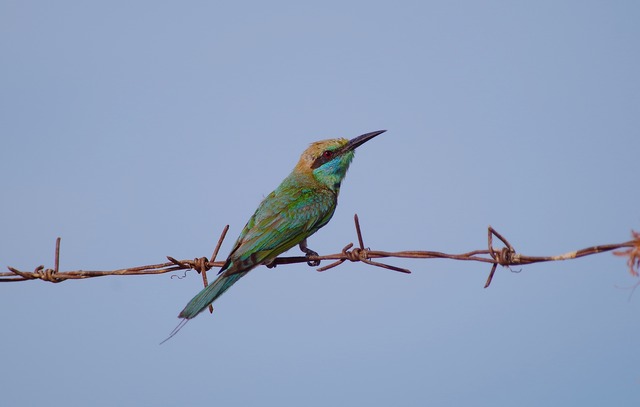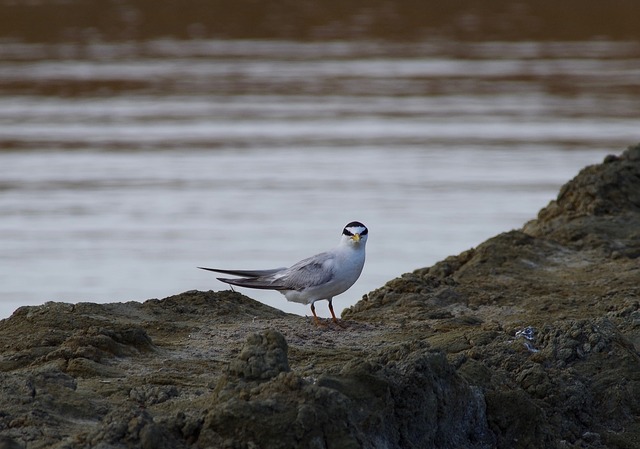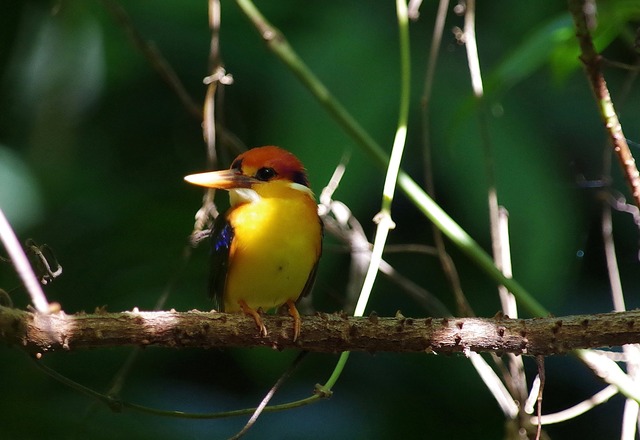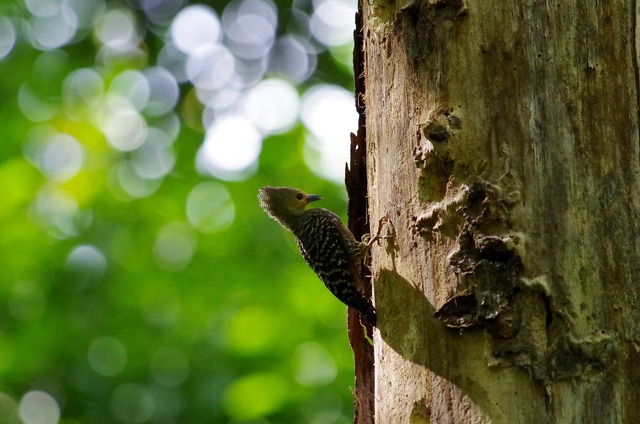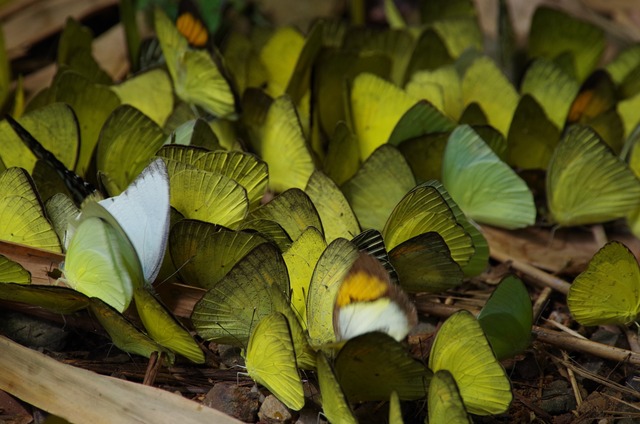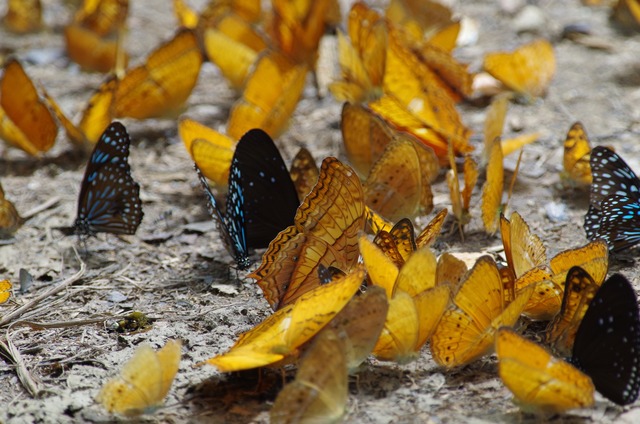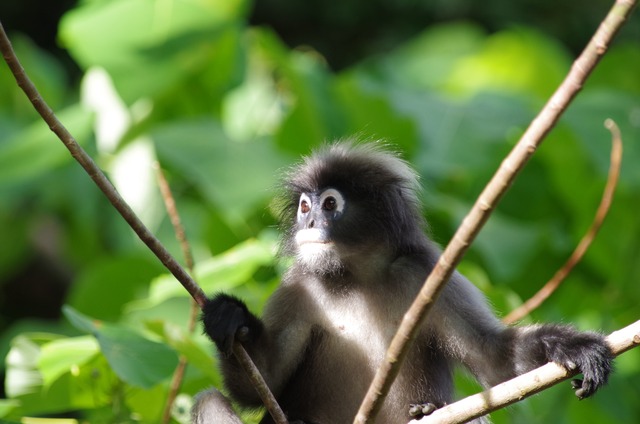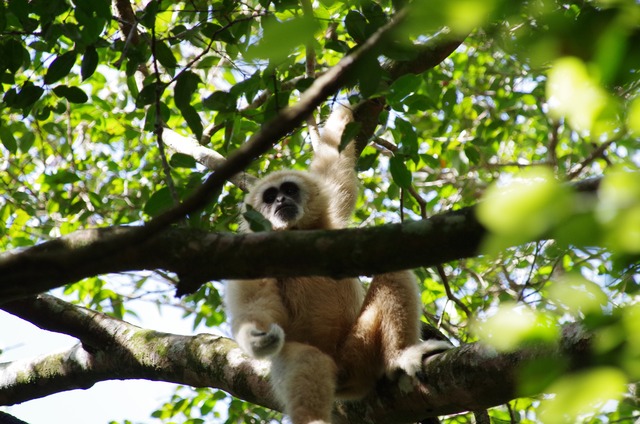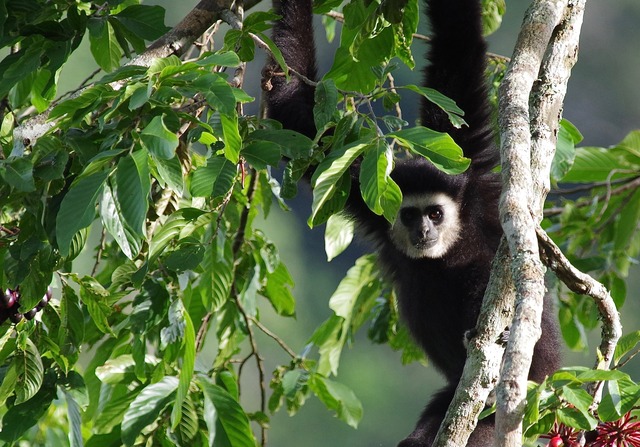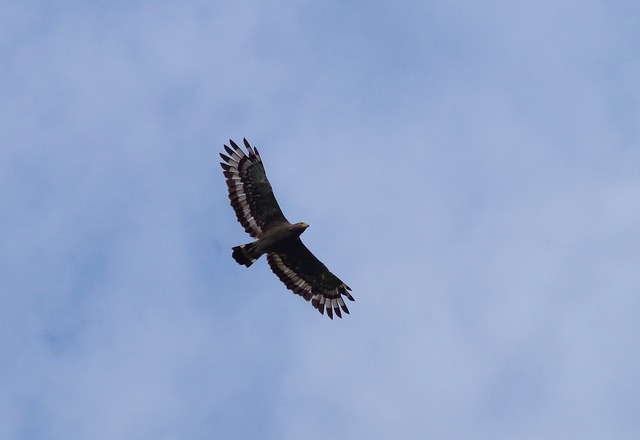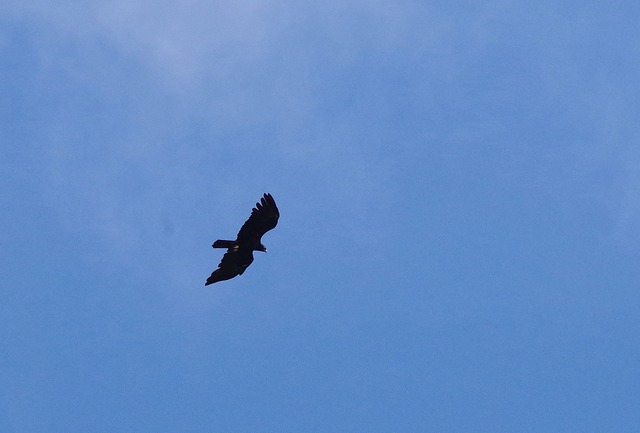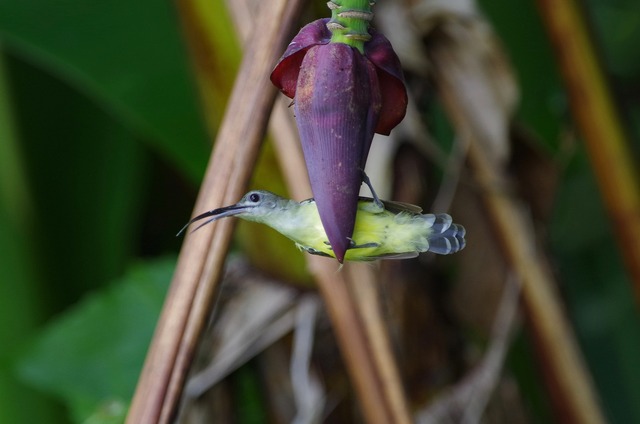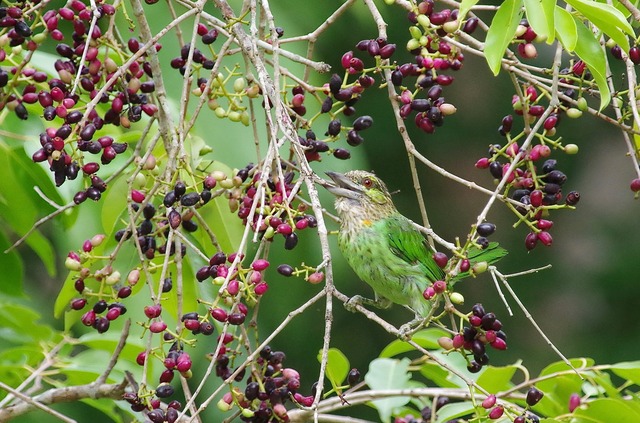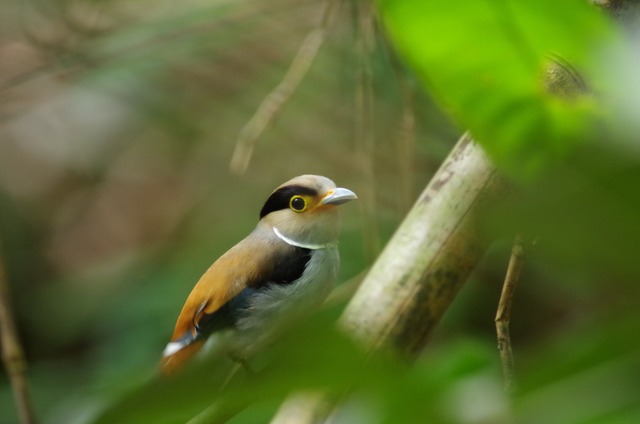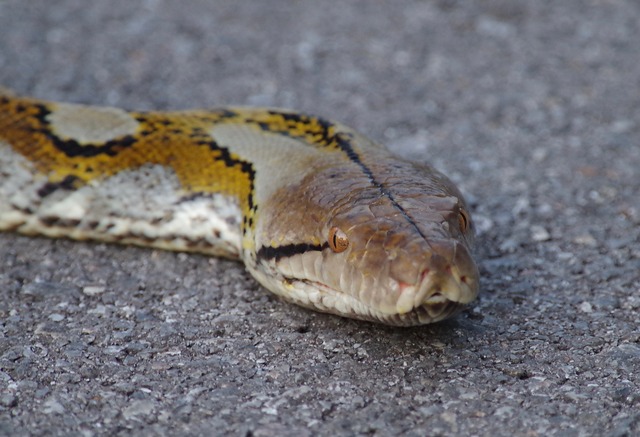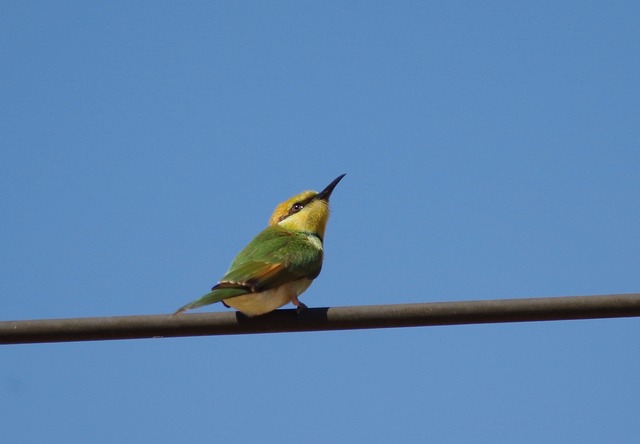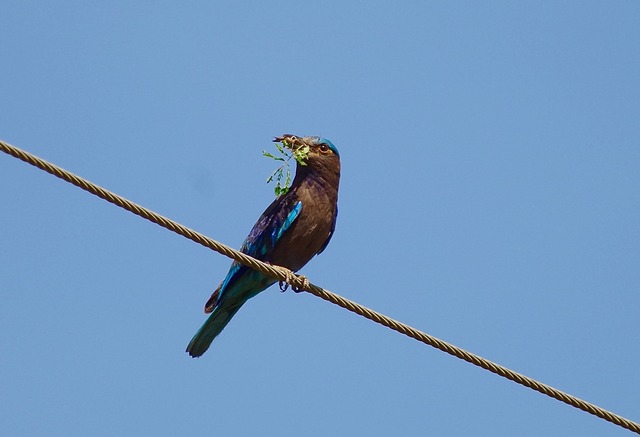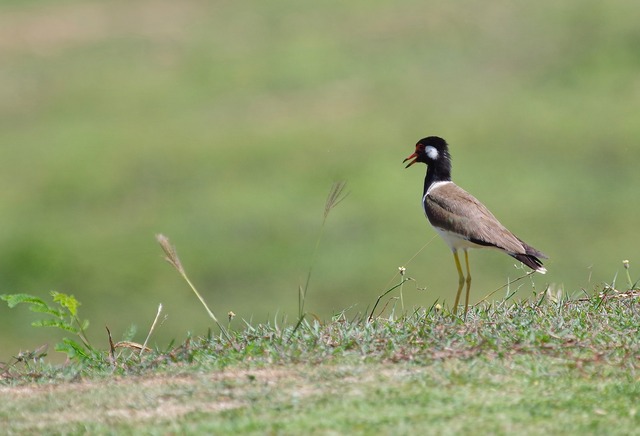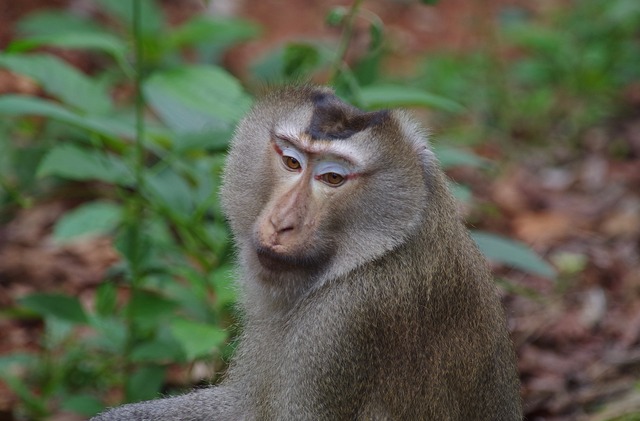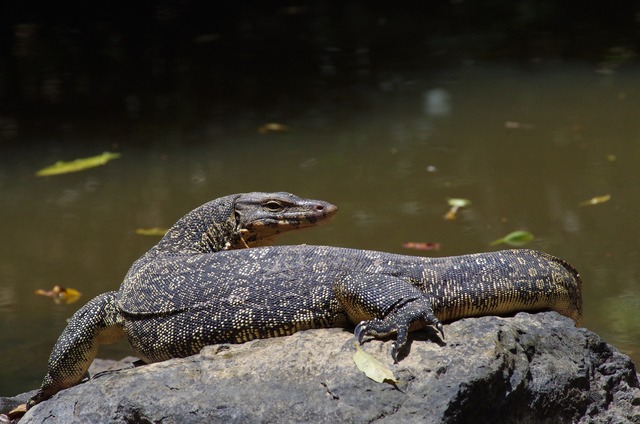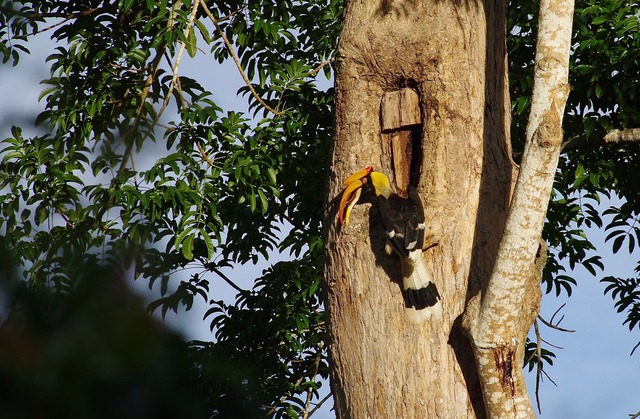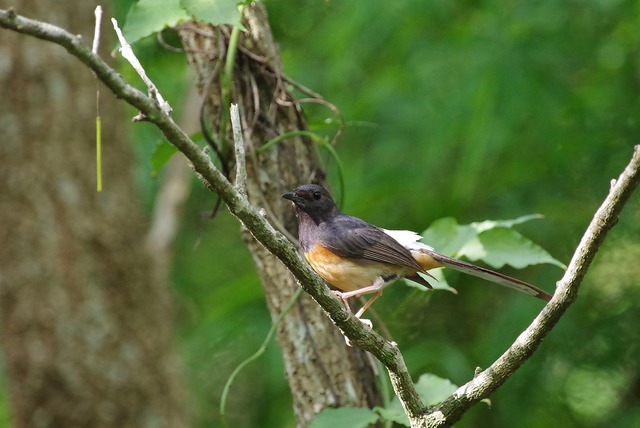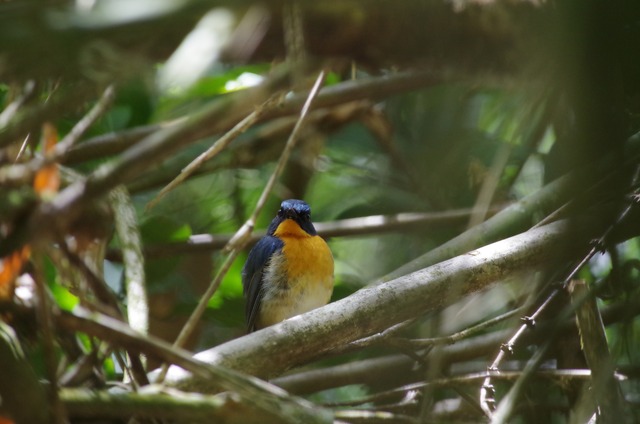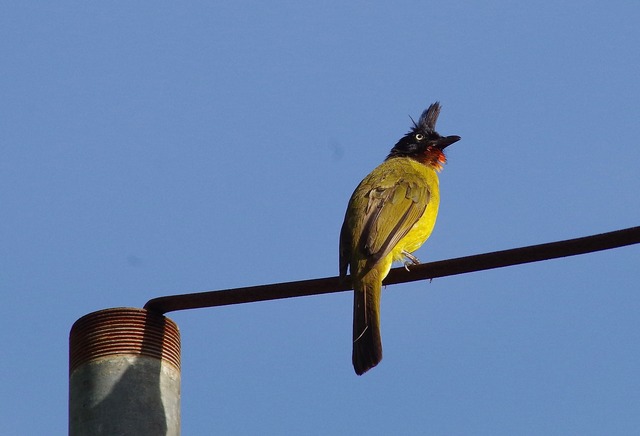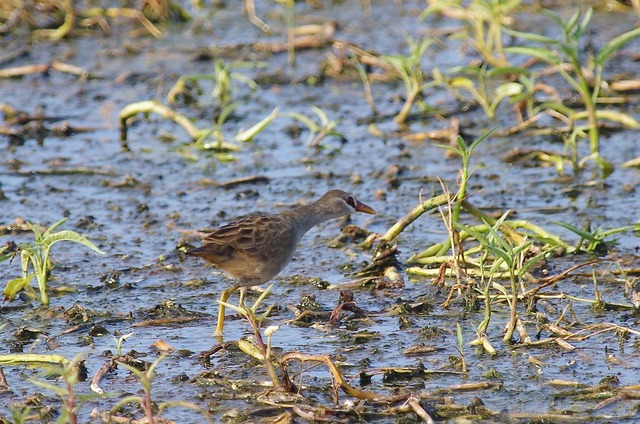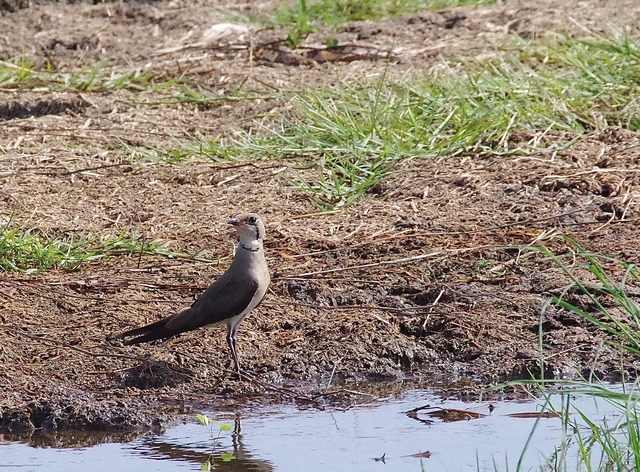Thailand June 16
Between June 4th-11th I spent 8 days birding in central Thailand. My 2 very good friends Jim Royer and Nick Armstrong joined me. Jim lives in Los Osos, California. Nick used to be his neighbor but has now moved back to good old England. We have made some previous trips as well and enjoy birding together. As I favor the Pittas I had some good expectations about seeing 3-4 of them as it is breeding time. The trip was great except for the fact we only saw one, the Blue-winged Pitta. Blue Pitta was heard many times and at one occasion we were so close that we couldn´t believe we didn't see it. As we drove out of Bangkok, our first stop was the wetlands at Petchaburi Rice fields. Here we had a good number of "open areas" birds. Many different Herons were seen as well as all 3 Weavers. Below you see the common Javan Pond Heron flying as well standing next to the much rarer Chinese Pond Heron together with some more
common Egrets.
Birding at locations like this is quite easy as long as you know your birds pretty well. Here the most handsome of the weavers, the Asian Golden Weaver.
Also common in this type of landscapes is the Asian Openbill Stork, which really has been given a correct name.
From here it´s quite close to the world famous Lam Pak Bia, where usually a few Spoon-billed Sandpiper is seen during winter. Of course we didn´t see any of these but we were lucky enough to spot both Greater Sand and Mongolian Plovers in breeding plumage as well as some other "summering" shorebirds. We followed the coast down to some traditional birding spots and managed to see this beautiful Green Bee-eater and some nesting Little Terns.
From here we had a few hours drive to the edge of Kaeng Krachang national park. This park is the biggest in Thailand and supports many good birds as well as the big mammals like tigers, bears and elephants. Seeing one is not likely though. Wildlife watching is usually limited to the main road and just small short tracks that are related to this road. Birding in the jungle is so much more difficult and can be really frustrating. Because of this we hired a local guide, Pia. His english is poor but he knows the birds and were to spot them and he is also polite. Compared to other countries, he is also quite cheap. We stayed 4 nights at the very nice Ban Maka chalets which is located just a few minutes drive from the park gate. We had early breakfast here and then took som lunch boxes with us with some standard nodles. Birding at Ban Maka can be really good and it was here we saw all the Blue-winged Pittas.
Ban Maka at 05.00.
Me and Nick with our guide Pia at the "top" at Kaeng Krachang. Myanmar in the back ground.
As said before, birding is hard in the jungle which makes photographing difficult. Still I managed to get some pictures of a few star birds. Below you see the Red-bearded Bee-eater, the very cute Black-backed Dwarf Kingfisher and the softly colored Buff-rumped Woodpecker.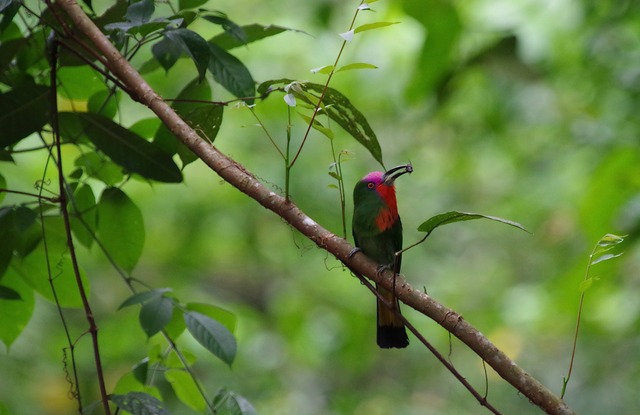
One thing that surprised me here was the enormous amount of butterflies. I have never seen anything close to this. I´m not exaggerating but there must have been 100.000 of these and maybe millions. Apparently, this is a major reason for photographers from all around the world to visit this park. In this case photos can´t do justice to the real world but these 2 pictures maybe gives you a small idea of this great nature phenomena.
Even if we did´t see any larger mammals we were lucky enough to spot some Gibbons and Leaf Monkeys. This Dusky Leaf Monkey showed interest in us when we made a short stop climbing up the hill at Kaeng Krachang.
At two times we also had decently close looks at the White-handed Gibbon, here in two different phases. The song of the Gibbons are truly one of the main songs in asian jungles, just great.
As we climbed further up the hill we saw our first raptor, a Crested Serpent Eagle which is the one most likely to encountered.
At the end of the drivable road at the parking for Tor Tip Waterfall we had great luck in seeing a pair of the rare Black Eagle soaring above us.
Up at the top we had lunch most days and next to the tables this Little Spiderhunter was feeding.
Right at the visitor centre there is an open space for camping but also some trees with fruits. This Green-eared Barbet had a feast with a few others. Not far from here in denser forest we also saw the brilliant Silver-breasted Broadbill.
One evening when we left the park (you have to be out before 19.00) this stunning Reticulated Phyton was warming up its body. It just lied there and didn´t want to move so we had to pull it away in its tail. Just another great experience.
Jim enjoying the Phyton.
When then started the long drive towards Khao Yai north east of Bangkok where we had booked us in to the upscale Balios resort. But just outside Ban Maka we saw this Chestnut-headed Bee-eater together with the colorful Indian Roller. On the open ground the common Red-wattled Lapwing showed nicely.
The Balios resort had a good deal for the room and it´s conveniently located just 5 minutes drive from the park. The also have a swimming pool which was great after 5 days of full birding.
Khao Yai is different in habitat even if the remote areas are full jungle where possibly tigers still roam. There are of course patches of rainforest here as well but you will also find several open areas with its own special birds. This park is also much more touristic and therefor you should avoid it during the weekends. The birding was also much slower here but still we saw quite a few new species. In this park the Pig-tailed Macaque is abundant as well as this Water Monitor Lizard next to the visitor centre.
Our first morning we had great views of Great Hornbills at nest, what a bird and powerful sound.
In the more dense forest White-rumped Shama is quite conspicuous and flew around us when we tried to see the Blue Pitta. A much harder bird was this Hill Blue Flycatcher we saw at high elevation.
The quite common Black-crested Bulbul has a special mark (race) in this park compared to the ones further south. It has a clear red spot on the throat.
Our last day we drove south of Bangkok to the Muang Boran Fish Ponds which is a great place for waterbirds and other species related to this type of habitat. However, don´t go here in your own car unless you have a GPS. There are so many small and narrow roads to pass before you find it. You can also bird it from two directions which will give you some different chances. At one spot we had 7 White-browed Crakes walking in a muddy area. This place is also full of the marvelous Oriental Pratincole of which we saw more than 100 individuals. A great place to finish a great trip.
Full species list.
Khaeng Krachang=KK, Khao Yai=KY, Petchabury Rice Fields=PRF, Pak Thale/ Lam Pak Bia=PT, Munang Boran Ponds=MB and Khao Lok Chang=KLC
Birds
- L. Whistling Duck. About 40 PRF and 2 MB.
- Cotton Pygmy Goose. 30 PRF and 15 MB.
- Scaly-breasted Partridge: A family heard KK
- Red Junglefowl. 2-4 seen both KK and KY
- Kalij Pheasant. 2 males KK
- Little Grebe 15 PRF and common MB.
- Asian Openbill. Common in suitable habitat.
- Painted Stork. About 10 birds south PT and 10 more at KLC.
- Milky Stork. One single bird south PT.10. Indian Cormorant. 3 seen at different spots PRF
10. Indian Cormorant. A few
11. Little Cormorant. Much more common.
12. Yellow Bittern. 1 seen flying at PRF and one more at MB.
13. Cinnamon Bittern. One seen flying which gave good looks and identification.
14. Purple Heron. One PRF.
15. Great Egret. Not counted, probably common.
16. Intermediate Egret. One bird seen PRF, maybe overlooked.
17. Little Egret. Se above.
18. Cattle Egret. Common.
19. Chinese Pond Heron. “ in full breeding Plumage PRF.
20. Javan Pond Heron. +100 in the areas around PRF.
21. Crested Serpent Eagle. 1 at KK and one more KY.
22. Black Eagle. Excellent views of a pair at the parking for Tor Tip waterfall, KK.
23. Black Kite (black eared). 2 in the vicinity of PRF.
24. Brahminy Kite. 3 around the same spots as above.
25. Raptor sp PRF
26. Slaty-breasted Rail. One seen flying and standing for a short while MB.
27. White-breasted Waterhen. Just a single bird PRF.
28. White-browed Crake. 6 birds were walking in an open mud spot MB.
29. Eurasien Moorhen. One at KLC.
30. Black-winged Stilt. Not uncommon at suitable spots.
31. Red-wattled Lapwing. Common through out.
- 32. Lesser sand Plover. One seen in full breeding plumage PT.
33. Gr. Sand Plover. At least one seen in breeding plumage. About 25-30 Sanplovers were seen at distance with difficulties in identification.
34. Pheasant-tailed Jacana. 5 beautiful birds at MB.
35. Bronze-winged Jacana. 6 seen at PRF and 6 more at MB.
36. Common Greenshank. 8 seen close to PT.
37. Far eastern Curlew. 8 at PT.
38. Oriental Pratincole. 10 seen at KK visitor centre and +100 at MB.
- 39. Tern sp.
40. Rock Pigeon. Yes
41. Red-collared Dove. Common first day at PRF and PT.
42. Spotted Dove. A few.
43. Little Cuckoo-Dove. 1 at KK
44. Emerald Dove. Quite common in KK and 1 at KY.
45. Zebra Dove. Common in open country.
46. Pink-necked Pigeon. 4 at PRF.
47. Thick-billed Pigeon. Seen at 2 occasions in KK and one in KY. Totally 23 birds.
48. Green Imperial Pigeon. 3 KY.
49. Mountain Imperial Pigeon. One at nest KK.
50. Banded Bay Cuckoo. 1 single bird at MB.
51. Asian Coal. Heard almost every day but never seen.
52. Green-billed Malkoha. 3 in KK and 2 KY.
53. Raffles´s Malkoha. 1 seen in KK.
54. Greater Coucal. 1-2 seen every day.
55. Asian Barred Owlet. Heard only in KLC and KY.
56. Large-tailed Nightjar. One sitting on the road just next to Ban Maka late afternoon.
58. Germain´s Swiftlet. 5 in KK and 20 in KY.
59. House Swift. One in KY.
60. Asian Palm Swift. About 10 PRF.
61. Red-headed Trogon. 5-6 in KK and 2 more in KY for this jewel.
62. Orange-breasted Trogon. A total of 3 in KK.
63. Eurasian Hoopoe. One at the feeder Ban Maka.
64. Great Hornbill. 1 in KK and 3 in KY of this magnificent bird.
65. Oriental Hornbill. 25 flew in at camp KK late evening. 4 in KY.
66. Wreathed Hornbill. 2 in KK and 2 flying in KY.
67. Black-backed Dwarf-Kingfisher. One at stake out and one close to stream 1, KK.
68. White-throated Kingfisher. 1 at Ban Maka and 2 in KY.
- 69. Red-bearded Bee-eater. One seen well in KK.
- 70. Blue-bearded Bee-eater. Heard both KK and KY and eventually seen briefly at KY.
71. Green Bee-eater. 2 seen south PT (rubbish tip).
72. Chestnut-headed Bee-eater. 2 seen on a wire next to Ban Maka.
73. Indian Roller. 2 at PRF and 2 at the same spot as the bird above.
74. Dollarbird. One seen at camp, KK.
75. Coppersmith Barbet. One in KK.
- 76. Blue-eared Barbet. 1-2 birds seen twice KK.
77. Green-eared Barbet. 6 in a fruiting tree at camp KK.
78. Moustached Barbet. 2 seen at high elevation KY.
79. Blue-throated Barbet. A total of 5 in KK.
- 80. Speckled Piculet. One each day in KK.
81. White-browed Piculet. One at higher elevation in KK.
82. Grey-headed Woodpecker. A pair at a open area just before camp in KK.
83. Common Flameback. One in KK and one at Ban Maka.
84. Buff-rumped Woodpecker. One at higher elevation, KK.
85. Greater Flameback. Totally 4 at KK.
- 86. Maroon Woodpecker. One nicely seen higher up KK.
87. Black-thighed Falconet. On eat stake-out just before camp, KK.
88. Red-breasted Parakeet. One flying over me while taking a swim at Balios resort.
- 89. Black and Red Broadbill. A total of 3 in KK.
- 90. Long-tailed Broadbill. 3 nicely seen at nest in KK.
91. Silver.breasted Broadbill. Seen at several occasions with a total of 11 birds.
- 92. Banded Broadbill. Seen near camp in KK. Also heard a couple of times.
93. Rusty-naped Pitta. Heard twice at higher elevation KK but never seen.
94. Blue Pitta Heard at two different spots in KK and also at 2 stake-outs in KY but sadly not seen.
95. Blue-winged Pitta. Easily seen at Ban Maka. Up to 6 birds present.
96. Bar-winged Flycatcher-Shrike. 2 seen in open area Ban Maka.
97. Ashy Woodswallow. 5 seen at PRF and about 10 in KY.
98. Common Iora. One at Ban Maka and 2 in KY.
99. Great Iora. One seen well just after gate entrance KK.
- Scarlet Minivet. 3 at KK and 2 more in KY.
- Blyth's Shrike Babbler. 2-3 seen high up KK.
- Black Drongo Seen at PRF, KK and KY.
- Bronzed Drongo. 2-3 seen every day in KK.
- Gr. Racket-tailed Drongo. 1-2 seen every day in KK.
- Malaysian Pied Fantail. A few at PRF and +10 MB.
- Black-naped Monarch. Seen with a few both KK and KY.
- Common Green Magpie. 2 seen each day in KK.
- Racket-tailed Treepie. One seen at Ban Maka.
- Ratchet-tailed Treepie. Heard only but very close.
- Large-billed Crow. 4 at different spots first day + one in KY.
- Indochinese Bushlark. One with the Bee-eaters and Rollers at Ban Maka.
- Pacific Swallow. 2 at PRF.
- Grey-headed canary-FC. 1 at higher elevation KK.
- Sultan Tit. One at KK.
- Velvet-fronted Nuthatch. 3 in KK.
- Black-headed Bulbul. Just one in KK.
- Black-crested Bulbul. Quite common, different races in KK and KY.
- Red-whiskered Bulbul. About 8-10 birds in KY.
- Sooty-headed Bulbul. 2 close to ban Maka and 2 more KY. (different races)
- Stripe-throated Bulbul. 2 at KK.
- Flavescent Bulbul. 2 at KK.
- Yellow-vented Bulbul. Quite common in open areas.
- Streak-eared Bulbul. 2 each in KK and KY. One at MB.
- Puff-throated Bulbul. 2 in KY.
- Ochraceous Bulbul. 6-7 in KK.
- Buff-vented (Olive) Bulbul. About 5 birds in KK.
- Ashy Bulbul.3-4 birds in KK and 2 more in KY higher up.
- Mountain Bulbul. 2 in KK.
- Yellow-bellied Warbler. 6-7 birds in KK.
- Zitting Cisticola. About 10 birds MB.
- Golden-headed Cisticola. 2-3 birds each day at KY.
- Dark-necked Tailorbird. One bird each day in KK.
- Yellow-bellied Prinia. 3 birds at MB.
- Plain Prinia. 2-5 birds at each open bird area visited.
- White-bellied Yuhina. 1 just before the gate KK and 2 in KY.
- Oriental (Hume's) White-wye. 2 waves with a total of 25 in KK and 2 more in KY.
- Chestnut-capped Babbler. 2 in KK and 1 in KLC.
- Pin-strped Tit-babbler. A total of 4 in KK.
- Golden Babbler. 3 in KK and 2 in KY.
- White-browed Scimitar-Babbler. 2 seen at different spots at KK.
- Puff-throated Babbler. 2 in KK and 1 in KY.
- Buff-breasted Babbler. Just one bird in KK.
- White-hooded (Collared) Babbler. 1-2 birds at higher elevation KK.
- Brown-cheeked Fulvetta. A total of 3 birds in KK.
- Black-throated Laughingthrush. 2 at higher elevation KK (+2 high up KY).
- Asian Fairy-bluebird. 1 at KK and 3 first morning just after the gate KY.
- Oriental Magpie Robin. Fairly common.
- White-rumped Shama. Fairly common in forest.
- Rufous-browed Flycatcher. 1 high up in KK.
- Hill Blue Flycatcher. One seen well high up at KY.
- Tickell´s Blue (Indochinese) Flycatcher. 2 birds at different spots in KK.
- Slaty-backed Forktail. 1 at KK.
- Little Pied Flycatcher. 2 birds in KY at different spots.
- Golden-crested Myna. 3 birds in a big tree at camp KK.
- Common Hill Myna. 2 birds in the same tree.
- Asian Pied Starling. Fairly common PRF and MB.
- Common Myna. As its name.
- White-vented Myna. Common.
- Blue-winged Leafbird. 6-7 birds in KK and 2 more in KY.
- Yellow-vented Flowerpecker. 2 single birds in KK.
- Orange-bellied Flowerpecker. 2 in KK and 1 at visitor centre KY.
- Plain Flowerpecker. 2 separate birds in KK.
- Fire-breasted Flowerpecker. 2 in KY.
- Scarlet-backed Flowepecker. A total of 5 in KK.
- Plain Sunbird. 1 in a birdvawe higher up KK.
- Olive-backed Sunbird. One at Balios Resort.
- Black-throated Sunbird. Totally 4 in KK.
- Little Spiderhunter. A total of 6 in KK.
- Yellow-eared Spiderhunter. 1 in birdwave KK.
- Streaked Spiderhunter. Same as above.
- Paddyfield Pipit.. 4-5 in open areas KY.
- House Sparrow. Yes.
- Plain-backed Sparrow. 2 near PRF and 2 in open area KY.
- Eurasian Tree Sparrow. Yes.
- Streaked Weaver. Common in PRF.
- Baya Weaver. 5 identified PRF.
- Asian Golden Weaver. +20 PRF. Also MB.
- Pin-tailed Parrotfinch. One female at stake-out KK.
- White-rumped Munia. 2 at open area Ban Maka.
- Scaly-breasted Munia. Afew at 3-4 spots.
Mammals/ others
- White-handed Gibbon. A family close and many heard at both parks.
- Dusky-Leaf monkey. A few seen at KK.
- Pig-tailed maqaque. A few at KK but more common in KY.
- Barking Deer. A few at Khao Yai
- Sambar Deer. A few at Khao Yai
- Reticulated Phyton. 1 big (3meters was lying on the road as we left KK for the evening)
- Butterflies. Must mention the absolutely stunning performance of all different butterflies at KK. Must have been tens of thousands (maybe hundred thousand) at KK. Just an amazing thing for its own right.

